It is a beautiful summer morning, and you visit your garden to pluck some mint leaves to make a refreshing mint salad for lunch later in the day. But wait! There are some holes in mint leaves. That indeed isn’t a great way to start your day! Is it? Let’s find out what is eating my mint leaves.
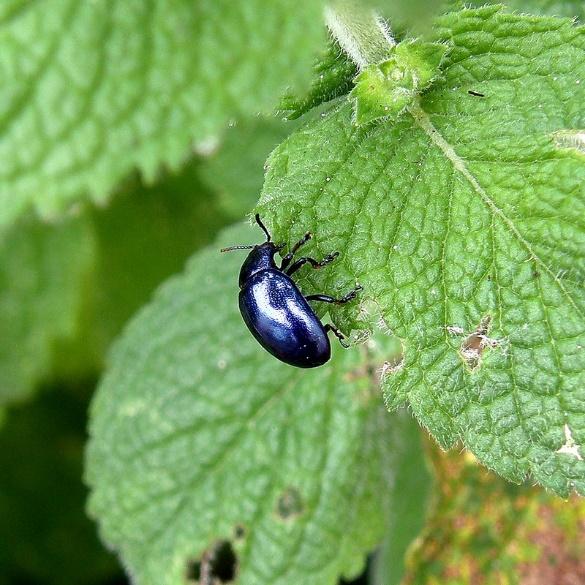
With no natural defenses, mint is a vulnerable herb that often falls prey to numerous pests.
You ask yourself, isn’t mint a herb? Aren’t herbs resistant to pests? Well, herbs are resistant to pests in most cases, but sadly, mint does not make it to that list.
There are many insects and other pests that are attracted to mint and can drill holes in its leaves. Pest infestation is the most common reason for holes to appear in mint leaves. These pests include aphids, caterpillars, flea beetles, mealybugs, and loppers that feed on mint leaves, leaving holes and wilting leaves behind.
Therefore, a bug is at blame if your mint isn’t growing as much as it should or seems undernourished. However, don’t be concerned. In this article, we’ll provide advice on dealing with pests that enjoy eating mint plants.
What Is Eating My Mint Leaves?
Before delving into the specifics of addressing common mint pests and how to get rid of them, let’s take a brief look at the most common mint pests and the common signs and indications of their presence.
Caterpillars & Loppers: leaves will be missing and have huge holes in them.
Mealybugs: will cause the leaves to become scrunched up and deformed.
Flea Beetles: will result in the formation of clusters of little holes in the leaves.
Aphids: sticky insects of a smaller size that can be found on the leaves.
Cutworms: cut through the plant’s stem, causing it to die.
Caterpillars & Loopers
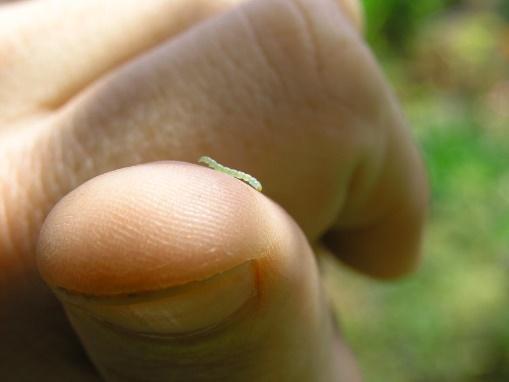
Caterpillars can attack mint overnight, leaving you with a nearly stripped plant.
Caterpillars and loopers are foliage-eating pests that mostly attack mint leaves at night. In contrast to loopers, which are smooth, green, and move by producing a half-loop with their body, caterpillars are often larger and hairier. Cabbage loopers are the most common type of loopers found in homegrown mint plants. Loopers are green and can grow up to an inch. Because of their size, they eat mint leaves in chunks, which can be used to confirm their presence. They cause severe damage to the plant. In addition to chunks, roughly eaten mint leaves is another indication of their presence.
Control
Sometimes you may find just a few loopers hanging out on mint leaves which can be easily picked by hand and removed, but if there are too many, you may have to try other alternatives. The best way to get rid of caterpillars and loopers is to use neem oil which is extracted from neem seeds. Neem oil is natural, easy to apply and does not harm mint leaves. Soapy water can also be sprayed on mint leaves and effectively removes caterpillars and loopers. Since mint leaves are usually consumed, synthetic insecticides should be the last option on the list because of their toxic side effects.
Mealybugs
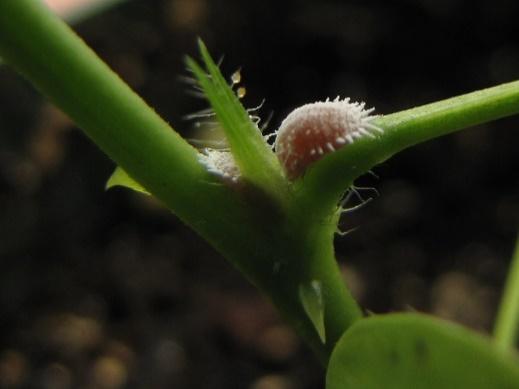
Mealybugs, a scale insect, consume plant sap and weaken or even kill its host plants.
Another pest that commonly attacks mint plants is mealybug. It thrives during warm and dry weather and is usually found in large numbers on the mint plant. These tiny oval-shaped insects are distinguishable from other pests by their distinctive white, fluffy wax covering.
Mealybugs feed on the stem and leaf sap of mint plants by piercing the mint with their needle-sharp mouthparts into the plant tissue. As they feed, mealybugs leave honeydew on the leaves and stem, promoting mold growth and attracting more pests.
A large colony of mealybugs can completely devastate mint and other plants in your garden in a matter of just a few days.
Control
Insecticidal soap is a widely used organic substance that is effective for soft body pests like mealybugs. It can be sprayed on mint leaves to eliminate mealybugs. Another helpful alternative is using diatomaceous earth.
Sprinkle diatomaceous earth on the soil around the mint plant. The sharp edges of diatomaceous earth puncture the delicate skin of mealybugs, causing dehydration and finally their death.
Flea Beetles
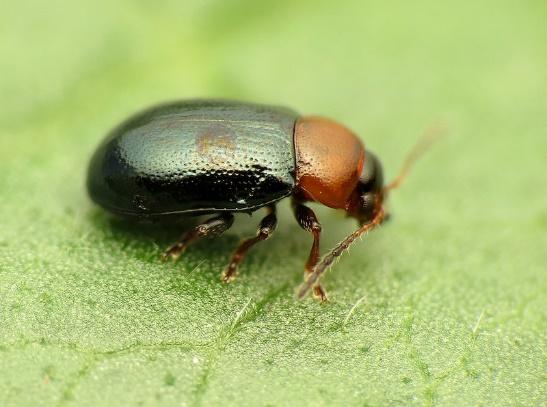
The flea beetle can do substantial harm to your mint plants’ roots and foliage.
Flea beetles are tiny insects, around ⅛ inch long. They have shiny, black-colored soft bodies with huge legs, making it easier for them to jump from one plant to another. Flea beetles are to blame if you see clusters of holes in your mint leaves. Flea beetles can seriously damage the overall health of your mint plant.
Adult flea beetles lay eggs in the soil after the spring feeding season. These eggs usually hatch around June, releasing larvae into the ground. These larvae attack the mint plants and begin to wreak havoc on the roots, eventually resulting in the mint’s death.
Control
Hanging sticky traps near mint plants can help reduce the flea beetle population. Sticky traps come in different sizes and shapes with glue pasted on them. Pests stick to these traps and cannot free themselves.
Parasitic nematodes can also prove useful in controlling flea beetles. Parasitic nematodes devour flea beetles from the inside, which helps in reducing the flea beetle population. They are also safe for humans and pets.
Aphids
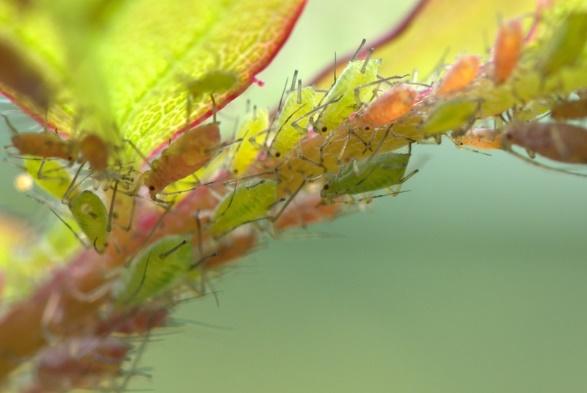
In most gardens, mint does well as a perennial. However, the plants are prone to aphid infestations.
Aphids are small-sized, sap-sucking pests usually found in large numbers on the mint plant and potentially able to cause excessive damage. They are around 2 to 4 mm long and green in color, which makes it nearly impossible to see them in mint leaves.
Aphids feed on young mint leaves by sucking the nutritious leaf sap. Devoid of leaf sap, mint leaves become discolored and may cause the plant to die if not treated in time. In addition, since aphids are sap-suckers, they produce honeydew on the mint leaves, which makes the mint plant prone to fungal infections and a source of attraction for other bugs.
Control
You can spray aphids off the mint plants using a garden hose with a strong stream of water. This approach is effective early in the season before an infestation has taken a stronghold in your mint plants.
Insecticidal soap is an organic substance that can also be converted into a powerful spray for the mint plant in your garden. On contact, it kills pests with soft bodies like aphids.
Cutworms
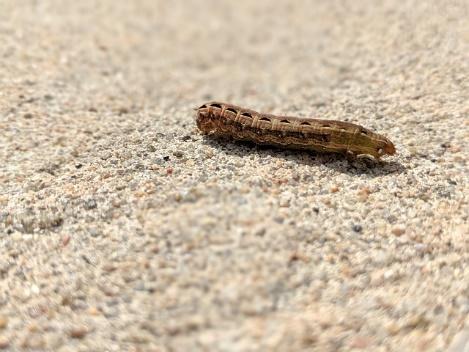
Mint cutworms are huge, yellow, brown, or greenish, with black patches all over their bodies.
They get their name because of their habit of feeding by slicing through the stems and leaves of plants. Cutworms are nocturnal feeders, and after they have finished their meals, they will hide in the soil during the day, either at the base of the plant or in its debris. So if your mint plants are infested with cutworms, you can find them if you dig down a little.
Even though the damage caused by these insects is comparable to that caused by the caterpillars and loopers, this bug is rarely a problem of economic significance on mint.
Control
Cutworms can best be controlled by insecticides like acephate and Dipel DF. Other control methods such as keeping the soil weed-free near mint plants where cutworms take shelter during the day can also be implemented to control their spread. Diatomaceous earth is also effective in killing cutworms by cutting through their bodies.
Spider Mites
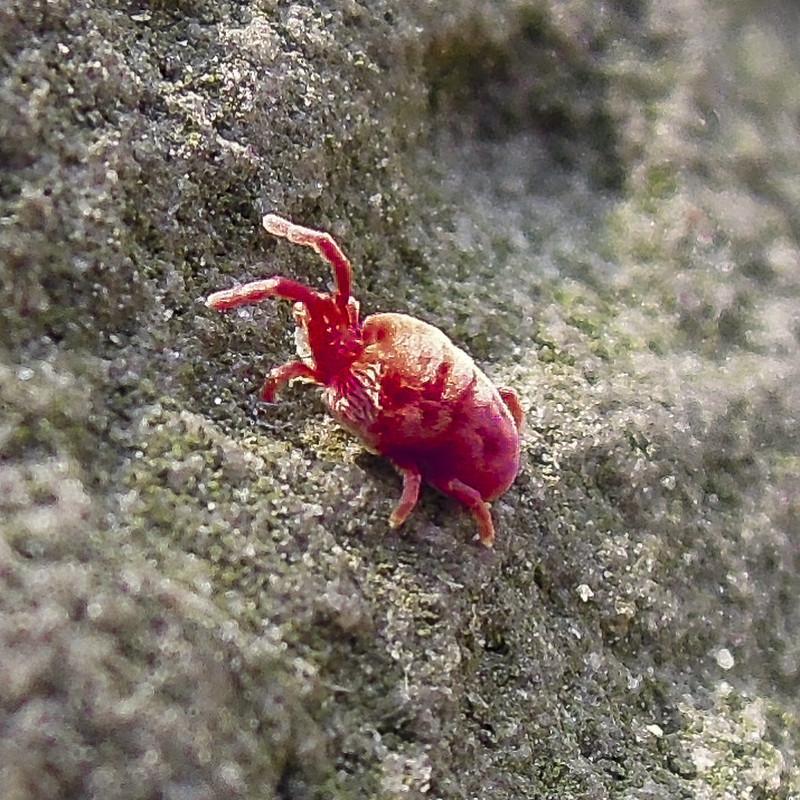
If they are not controlled, spider mites can cause severe harm to a mint plant.
These tiny, translucent-colored bugs dwell on the undersides of mint leaves and tend to cluster closer to the top of fresh growths. Their size ranges from 3 to 4 millimeters. Spider mites are able to thrive in hot and dry environments, and they inflict damage to plants by making very small holes in the leaves.
If you observe yellow or brown spots on the leaves of your mint plant, you may have a spider mite infestation going on.
Moreover, if your plant has spider mites, there is a good chance that it is also suffering from an inadequate supply of water. You will most likely notice them attacking your mint plant between the months of April and July.
Control
Neem oil is a natural miticide, a substance that eliminates infestations of mites. Spray the leaves of your mint plant liberally with neem oil to eradicate spider mites. You can also introduce beneficial insects, like ladybugs, that feed on spider mites. Increasing your irrigation frequency can also help with your spider mite problem since these pests like dry, arid conditions.
Final Thoughts
Mint can be planted just once, and it quickly spreads and covers the ground. Mint has a wonderful fragrance and can be used in various meals and salads. However, despite its rapid growth and hardiness, it could be attacked by different pests.
So, examine your plant frequently for any damage to the foliage, stem injuries, or bad soil scents. You can put up physical barriers to stop insects from approaching your plant. You could also use diatomaceous earth or sticky traps around your mints to keep insects away.
Plants that are growing strong, well-fed, and have enough water and nutrients can fend off pests more easily. Also, be sure to time your pest control properly while treating an infestation. Cutworms, for instance, are more active at night and are therefore easier to find.
Frequently Asked Questions
What can I spray my mint with?
One of the simplest and most potent insect treatments you can use on your mint plant is soap spray! It will deal with a wide range of pests, including caterpillars, aphids, and mealybugs. Plant-based insecticides like pyrethrum or rosemary oil are another option. These can eliminate the mites without harming the plant or other animals.
What animals will eat a mint plant?
There is no evidence based on scientific studies to suggest that growing mint in a garden will deter animals or other pests. In fact, they are preyed upon by various unwanted insects and animals, including loopers, caterpillars, flea beetles, spider mites, and mealybugs.
How can we protect mint from pests?
Spraying a dish soap solution and water over the affected plants can help control a minor infestation. Other techniques include applying mulch, pouring water to wash off pests, or placing something shiny and colorful near your mint plants to keep the bugs away.
Do rats eat mint plants?
On many different websites across the internet, mint is promoted as an effective rat repellent. Rats are allegedly driven off by their strong smell, which is sufficient enough to keep them away. Do not, however, anticipate that a small amount of mint oil or a few mint plants will totally eradicate the rat population.
How do you keep mint plants healthy?
Mint thrives on medium-rich, evenly damp, but not soggy soil. To prevent mint plants from invading your garden and crowding themselves, plant them 18 to 24 inches apart, and it’s best to grow them in pots. In addition to this, be on the lookout for any bug or pest infestations.
How often should you water a mint plant?
Mint plants don’t need much care, but they need to be watered frequently. Depending on the environment, mint plants typically require 1 to 2 inches of water every week. So, you should normally water indoor plants in a pot or container once every few days.
What eats holes in mint leaves?
Flea beetles, spider mites, and aphids are a few of the many pests that devour the leaves of your mint plants. Spider mites are the most harmful parasites that can feed on mint. In addition to eating the plants, they also leave behind unsightly webs. However, using the techniques described in this article, all of these insects and pests can be easily handled.
Sources For Further Reading
Managing Pests in Gardens: Herbs: Mint. (2022). Retrieved 29 July 2022, from http://ipm.ucanr.edu/home-and-landscape/mint/
Mint | Diseases and Pests, Description, Uses, Propagation. (2022). Retrieved 29 July 2022, from https://plantvillage.psu.edu/topics/mint/infos
Mint – Gardening Solutions – University of Florida, Institute of Food and Agricultural Sciences. (2022). Retrieved 29 July 2022, from https://gardeningsolutions.ifas.ufl.edu/plants/edibles/vegetables/mint.html
Mint | Cooperative Extension | University of Delaware. (2022). Retrieved 29 July 2022, from https://www.udel.edu/academics/colleges/canr/cooperative-extension/fact-sheets/mint/
Editor’s Recommendations
What are the Best Practices to Get Rid of Thrips on Houseplants?
Effective Ways To Get Rid Of Russet Mites On Houseplants
Springtails on Houseplants & Effective Ways to Get Rid of Them?







